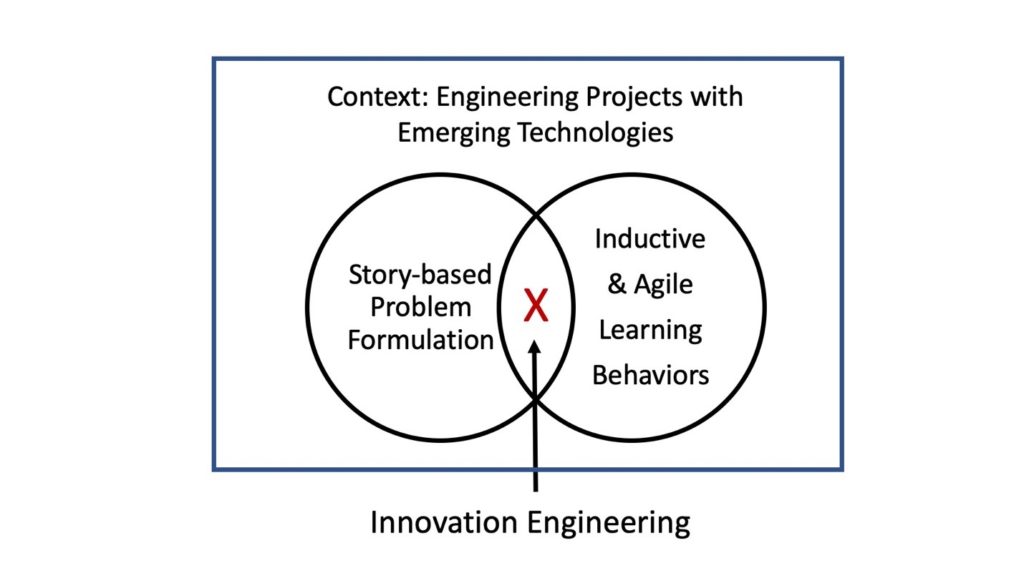Innovation Engineering is a framework for engineering solutions with innovation and emerging new technologies. It applies systemized innovative thinking to existing business and technology problems and is primarily used by research labs, large organizations, SMEs, startups, and students. This framework is practical for anyone interested in finding innovative new approaches to problems.
This way of thinking can “increase… innovation speed to market by up to six times, while decreasing risk by up to 80%.” (EEEN). With Innovation Engineering, the technological envelope can be pushed in an efficient, cost controlled, profitable way. The risks of pursuing big ideas, new business designs, and novel solutions are also mitigated.
This is appealing for forward-thinking organizations who value purposeful action and financial prudence.
As you can see from the Venn diagram below, innovation engineering perfectly balances between a story-based approach, and using inductive and agile learning in approaching new and unique solutions in a fresh way.
The Innovation Engineering Method – Overview
1) Identify the Problem
2) Iterate on ideas to manually solve and draft potential solutions
3) Put yourself into the user’s perspective and walk through solution ideas from a user-first perspective
4) Break down the solution into sections based on logical factors
5) Iteratively research and apply technology to design an innovative solution
Using Stories, Inductive Learning, and Agile Adaptive Behavior
Create a Story
The process of Innovation Engineering begins by turning a problem into a narrative story. This is a possible solution for the problem, put into the context of the team personnel’s background and relevant world changes. This story is then used to garner support and validate the premise. Stories are specifically about learning, not specific ways to execute. Don’t get ahead of yourself!
Stories can be technical (with low-tech demonstrations or prototypes) or focused on social contexts such as business networks, operation models, or mission strategies.
In general, the clearer the story, the more successful the project!
Use Inductive Learning
Innovation Engineering uses observation of specific example cases to discover insights and gather new knowledge. Inductive learning is a core practice of Innovation Engineering.
Be Adaptive and Agile
IE also sources stories and inductive learning from entrepreneurship best practices. Engineering principles come into play with adaptive, agile behavior.
This is what facilitates controlled, risk-managed, rapid practical innovation.
The Innovation Engineering Process
Ikhlaq Sidhu, Chief Scientist at UC Berkeley, has condensed the cultural practices of Innovation Engineering into twelve main principles which support an effective process.
1. The Story Comes First
Stories give contextual understanding of the problem-solution hypothesis and objective. They help to win stakeholder support and resources from those who may not be moved by purely technical information. Stories can be different lengths or complexity levels, but must contain new insight and show stakeholder benefit.
2. Determine Your Path: Invent or Scale?
There are two options for innovation: invent something new or scale what’s already been tested. Invention requires a learning focused path with a team capable of producing new insights. Organizations looking to scale what has already been done, need someone capable of executing.
3. Be User-Centered
Technical problems must be framed around the final user benefits. The IE story places the user first, then speaks to the technical solutions that deliver that benefit.
4. Effectuation
Understand the resources available and begin the work according to those capabilities. Take an inventory of what is readily usable now The analogy described by Ikhlaq Sidhu from Berkeley compares that if you were making dinner, you have two choices: decide on a dish to make and then gather those ingredients (not effectuation), or look in your kitchen for what is available now and then craft your meal with what you have (this is effectuation). Clearly the latter approach can offer a lot of benefits in the ability to execute, as well as using your own institutional knowledge and skills you already have.
Effectuation can be defined as a form of reasoning or problem solving that acknowledges that while the future is unpredictable, it can be controlled through human actions.
5. Break Things Down
Understand the granular components of the potential solution and the way they relate to one another.
6. Seek Insight
A well-written, user-centered problem story contains clues on the true value and hidden potential of the solution. Careful examination of the end user will reveal this.
7. Minimal Viable System Architecture
All stories should begin with the simplest, quickest system version. System architecture can grow more complex over time, but should always be founded on the most unembellished model possible.
8. Agile Increments
Once a successful model is established, development is done incrementally without necessarily moving to a particular final result.
9. Simplicity
Simple, iterative development ensures that technical solutions can be understood, explained, and quickly debugged.
10. Downside Reduction
Disruption must be managed for innovation to be feasible within organizations. This requires considering technical and business risks of change, downtime, or possible failure.
11. Measurable Objectives
Success must be measured against real, quantified metrics. When objectives, unit economics are considered helps to determine what is worth doing and what has been successful.
12. Supportive Ecosystem
Innovation Engineering needs to be supported with a network of high-level partners. These can be individuals (internal or external to the company) or organizational.
Innovation Engineering in Action
The systemized Innovation Engineering process has brought over $16 billion of innovations to market. This method is so effective at consistently delivering successful innovations, it outperforms other methodologies. Beyond major developments, new ventures, or lab projects, Innovation Engineering can also help with small daily challenges. Some of the leading new technologies being explored are AI, cloudtech, blockchain, 5G, and IoT. There are many potential use cases for using this way of thinking.
Here are a few examples of inventions made by applying emerging technologies to existing issues:
Smart Bins
People don’t always recycle or properly sort refuse. AI, the cloud, and new scanning technology can turn regular garbage receptacles into smart bins which tells people where to place their trash.
IoT Fire Monitoring
IoT devices, 5G connections, and AI can detect adverse events like fires, when no one is around to call 911.
Clean Lead Recycling
Recyclable lead-acid batteries are staples for cars and server farms, but traditionally processed dirty. New technologies are being used to process them cleanly and meet demand in an environmentally friendly manner.
How do we describe a company that embodies the innovative engineering spirit?
-
Innovative Engineering creates meaningful, useful, valuable change. It does this practically, objectively, and carefully.
-
Organizations that value and cultivate their intellectual capital stay on the leading edge. Innovation Engineering gives a method for turning this resource into a value-creating powerhouse.
-
Employing this method means using a streamlined innovation pipeline that tracks against key business metrics and delivers good unit economics.
Organizations who practice Innovation Engineering are able to effectively prioritize creative thinking, capture meaningful ideas, and bring those to fruition.
Promoting creativity without targets, objectives, or measured controls leads to waste. On the other hand, creative thinking can’t be expected to successfully create innovation without the organization’s holistic support. Innovation Engineering avoids both these issues, by iteratively orienting company resources around a beneficial user story.
Organizations who already innovate at some level can use Innovation Engineering to assess their current effectiveness. Optimism based culture or professed ideals can be tested against data and metrics.
We think it’s important to note that Innovation Engineering requires a supportive culture within the entire organization. Every member is a creative, natural problem solver with valuable contributions to make. When policies and procedures for innovation are formalized as written documents, this ensures that all departments work towards the common goal of successful innovation development.
Outside partners who practice Innovation Engineering are vital. Innovative partners experienced in strategy, design, and project delivery provide support for company endeavors and help guide organizations new to the method.
Sphere Partners is available as your on-demand Innovation Engineering team. Contact us today to discover what leading edge solutions we bring to organizational technology challenges.
Find our full stack of innovation & engineering services here, including web app engineering, AR, VR, advanced DevOps practices and more.








